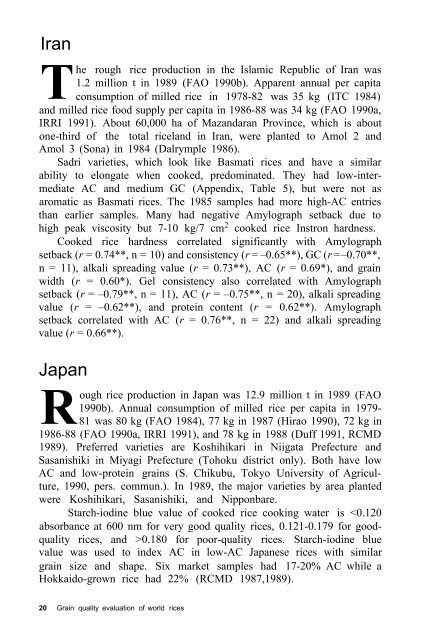Juliano et al. - 1993 - Grain Quality Evaluation of World Rices
Juliano et al. - 1993 - Grain Quality Evaluation of World Rices
Juliano et al. - 1993 - Grain Quality Evaluation of World Rices
You also want an ePaper? Increase the reach of your titles
YUMPU automatically turns print PDFs into web optimized ePapers that Google loves.
Iran<br />
T<br />
he<br />
rough rice production in the Islamic Republic <strong>of</strong> Iran was<br />
1.2 million t in 1989 (FAO 1990b). Apparent annu<strong>al</strong> per capita<br />
consumption <strong>of</strong> milled rice in 1978-82 was 35 kg (ITC 1984)<br />
and milled rice food supply per capita in 1986-88 was 34 kg (FAO 1990a,<br />
IRRI 1991). About 60,000 ha <strong>of</strong> Mazandaran Province, which is about<br />
one-third <strong>of</strong> the tot<strong>al</strong> riceland in Iran, were planted to Amol 2 and<br />
Amol 3 (Sona) in 1984 (D<strong>al</strong>rymple 1986).<br />
Sadri vari<strong>et</strong>ies, which look like Basmati rices and have a similar<br />
ability to elongate when cooked, predominated. They had low-intermediate<br />
AC and medium GC (Appendix, Table 5), but were not as<br />
aromatic as Basmati rices. The 1985 samples had more high-AC entries<br />
than earlier samples. Many had negative Amylograph s<strong>et</strong>back due to<br />
high peak viscosity but 7-10 kg/7 cm 2 cooked rice Instron hardness.<br />
Cooked rice hardness correlated significantly with Amylograph<br />
s<strong>et</strong>back ( r = 0.74**, n = 10) and consistency ( r = –0.65**), GC ( r = –0.70**,<br />
n = 11), <strong>al</strong>k<strong>al</strong>i spreading v<strong>al</strong>ue ( r = 0.73**), AC ( r = 0.69*), and grain<br />
width ( r = 0.60*). Gel consistency <strong>al</strong>so correlated with Amylograph<br />
s<strong>et</strong>back ( r = –0.79**, n = 11), AC ( r = –0.75**, n = 20), <strong>al</strong>k<strong>al</strong>i spreading<br />
v<strong>al</strong>ue ( r = –0.62**), and protein content ( r = 0.62**). Amylograph<br />
s<strong>et</strong>back correlated with AC ( r = 0.76**, n = 22) and <strong>al</strong>k<strong>al</strong>i spreading<br />
v<strong>al</strong>ue ( r = 0.66**).<br />
Japan<br />
R<br />
ough<br />
rice production in Japan was 12.9 million t in 1989 (FAO<br />
1990b). Annu<strong>al</strong> consumption <strong>of</strong> milled rice per capita in 1979-<br />
81 was 80 kg (FAO 1984), 77 kg in 1987 (Hirao 1990), 72 kg in<br />
1986-88 (FAO 1990a, IRRI 1991), and 78 kg in 1988 (Duff 1991, RCMD<br />
1989). Preferred vari<strong>et</strong>ies are Koshihikari in Niigata Prefecture and<br />
Sasanishiki in Miyagi Prefecture (Tohoku district only). Both have low<br />
AC and low-protein grains (S. Chikubu, Tokyo University <strong>of</strong> Agriculture,<br />
1990, pers. commun.). In 1989, the major vari<strong>et</strong>ies by area planted<br />
were Koshihikari, Sasanishiki, and Nipponbare.<br />
Starch-iodine blue v<strong>al</strong>ue <strong>of</strong> cooked rice cooking water is 0.180 for poor-qu<strong>al</strong>ity rices. Starch-iodine blue<br />
v<strong>al</strong>ue was used to index AC in low-AC Japanese rices with similar<br />
grain size and shape. Six mark<strong>et</strong> samples had 17-20% AC while a<br />
Hokkaido-grown rice had 22% (RCMD 1987,1989).<br />
20 <strong>Grain</strong> qu<strong>al</strong>ity ev<strong>al</strong>uation <strong>of</strong> world rices

















